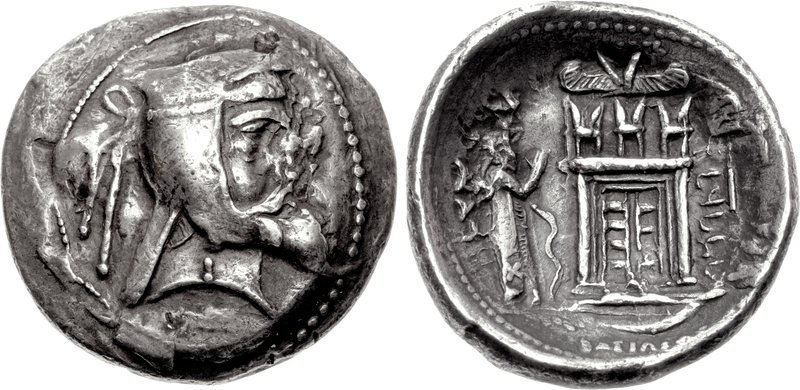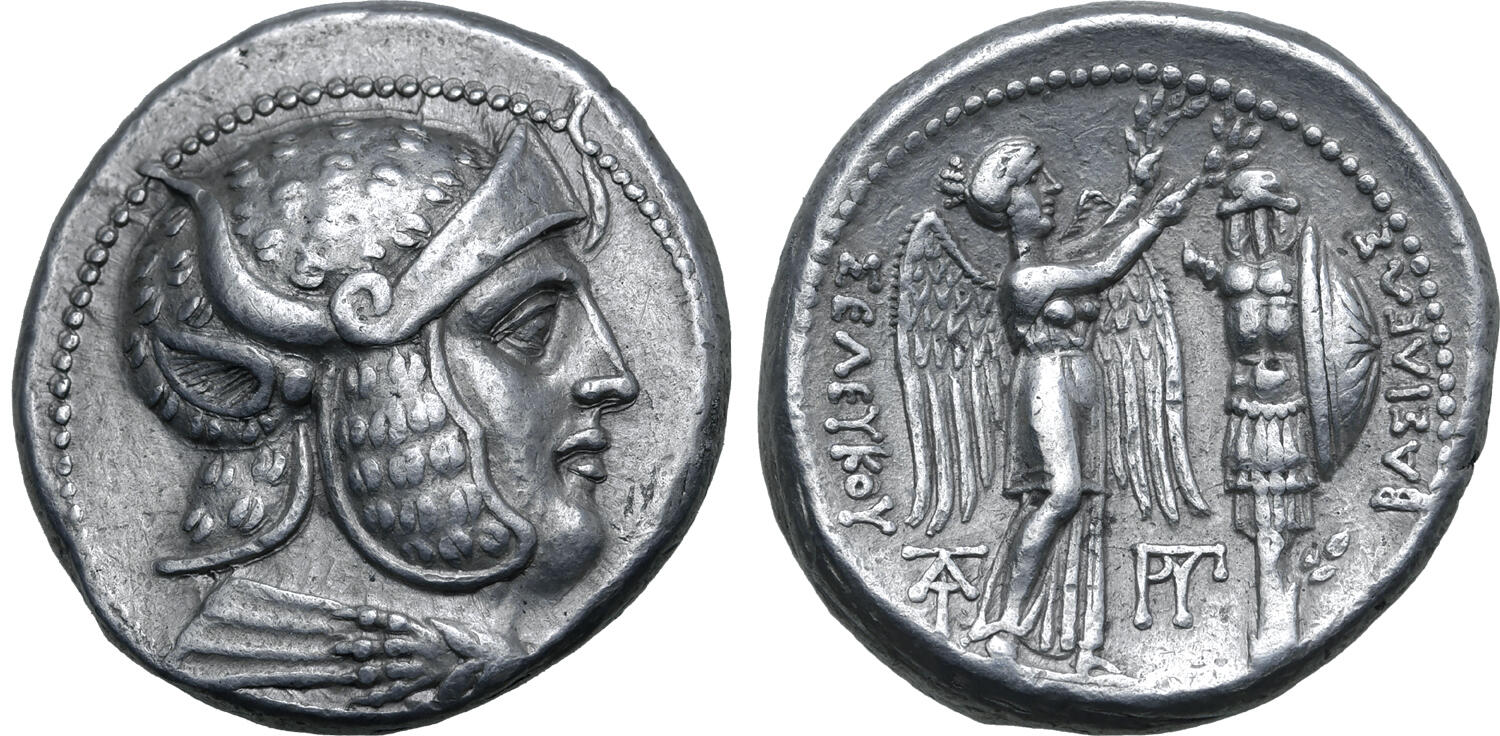240 BCE - 200 BCE | wtpr in Aramaic to outer right; p in Aramaic to inner right; (lh' in Aramaic) in exergue: "Vadfradad, the Frataraka of the Gods, Son"
Overstriking coin
Vadfradad_I_CNG,_90,_23_May_2012,_788.jpg
[1]
Overstruck variety
S402 Susa Seleucus I tetradrachms trophy.jpg
[2]
|
|
Sale(s)Sale(s) ᵖ:
|
Baldwin’s, 44, 2 May 2006, 105 = Classical Numismatic Group, 90, 23 May 2012, 788
|
|
|
|
Description
| ObverseInscription or printing placed on the obverse.:
|
Head of Vadfradat right, wearing earring, satrapal cap (kyrbasia) and diadem. Border of dots.
|
ReverseInscription or printing placed on the reverse.:
|
wtpr in Aramaic to outer right; p in Aramaic to inner right; (lh' in Aramaic) in exergue: "Vadfradad, the Frataraka of the Gods, Son" (Aramaic) Fire Temple with half-figure of Ahura-Mazda, to left, satrap standing right, in prayer and bow, to right, standard. Border of dots.
|
Mint and issuing power
| MintIdentifies the place of manufacture or issue of a numismatic object.:
|
Istakhr (Persepolis)
|
Ancient regionAncient region.
|
Persis
|
Modern countryModern country: Iran
|
AuthorityIdentifies the issuing power. The authority can be "pretended" when the name or the portrait of X is on the coin but he/she was not the issuing power. It can also be "uncertain" when there is no mention of X on the coin but he/she was the issuing power according to the historical sources:
|
Kingdom of Persis, Vadfradad II of Persis
|
Chronology
| FromIdentifies the initial date in a range assigned in a numismatic context. 240 BCE toIdentifies the final date in a range assigned in a numismatic context.. 200 BCE
|
Hellenistic 323-30 BC  periodTime period of the numismatic object. periodTime period of the numismatic object.
|
Physical description
MetalThe physical material (usually metal) from which an object is made.: Silver 
|
WeightWeight of the numismatic object (in grams). in grams: 16.7716.77 g <br />16,770 mg <br />
|
DenominationTerm indicating the value of a numismatic object. Examples: tetradrachm, chalkous, denarius.: tetradrachm 
|
AxisDescribes the directional relationship between the obverse and reverse of a numismatic object.: 33 mm <br />0.3 cm <br />
|
| DiameterDescribes diameter of an object (in mm).: 3131 mm <br />3.1 cm <br />
|
StandardStandard.: Attic
|
References
| Coin referenceReference of the Coin:
|
Van't Haaff 2020, p. 77, n° 533
|
Coin series referenceReference to coin series study:
|
Alram 19861Alram 1986, n° 533-538, Klose - Müseler 20082Klose - Müseler 2008, 2/17, Nelson 20113Nelson 2011, n° 569, Van't Haaff 20204Van't Haaff 2020, p. 77, n° 533
|
Description
| ObverseInscription or printing placed on the obverse.:
|
Head of Seleucus I Nikator right, wearing a helmet covered by a panther skin, with ears and horns of a bull, a panther skin around the neck. Border of dots.
|
ReverseInscription or printing placed on the reverse.:
|
ΒΑΣΙΛΕΩΣ ΣΕΛΕΥΚΟΥ (Greek) Nike standing right, crowning trophy. Border of dots.
|
Mint and issuing power
Chronology
| FromIdentifies the initial date in a range assigned in a numismatic context. 301 BCE toIdentifies the final date in a range assigned in a numismatic context.. 295 BCE
|
Hellenistic 323-30 BC  periodTime period of the numismatic object. periodTime period of the numismatic object.
|
Physical description
| DenominationTerm indicating the value of a numismatic object. Examples: tetradrachm, chalkous, denarius. ᵖ:
|
tetradrachm 
|
StandardStandard. ᵖ:
|
Attic
|
References
| Frequency of overstrikesFrequency of overstrikes:
|
frequent
|
Level of confidenceLevel of confidence of the identification:
|
|
| RemarksRemarks:
|
"Overstruck on a Susa mint tetradrachm of Seleukos I, head of hero / Nike & trophy type (SC 173.13; ESMS Tr. 82 [A55/P17]), with much of the undertype clearly visible."
|
References
- ^ Alram, Michael (1986), Iranisches Personennamenbuch. Band IV: Nomina Propria Iranica In Nummis, Vienna.
- ^ Klose, Dietrich O. A. - Müseler, Wilhelm (2008), Statthalter Rebellen Könige - Die Münzen aus Persepolis von Alexander dem Großen zu den Sasaniden, Munich, xii, 90 p.
- ^ Nelson, Bradley R. (2011), Numismatic Art of Persia: The Sunrise Collection Part I: Ancient- 650 BC to AD 650, Lancaster
- ^ van't Haff, Pieter Anne (2020), Catalogue of Persis Coinage, Ca. 280 B.C. - A.D. 228, 2020
- ^ Sear, David R. (1979), Greek coins and their values. Vol. II, Asia and North Africa, London, xlviii, p. 317-762
- ^ Houghton, Arthur - Lorber, Catharine (2002), Seleucid coins : a comprehensive catalogue. Part 1, Seleucus I through Antiochus III, New York - Lancaster - London, 2 v. (xxxviii, 488 p. + 300 p.), 101 pl.
- ^ Hoover, Oliver D. (2009), Handbook of ancient Syrian coins : royal and civic issues, fourth to first centuries BC, The Handbook of Greek Coinage 9, Lancaster, lxix, 332 p.

